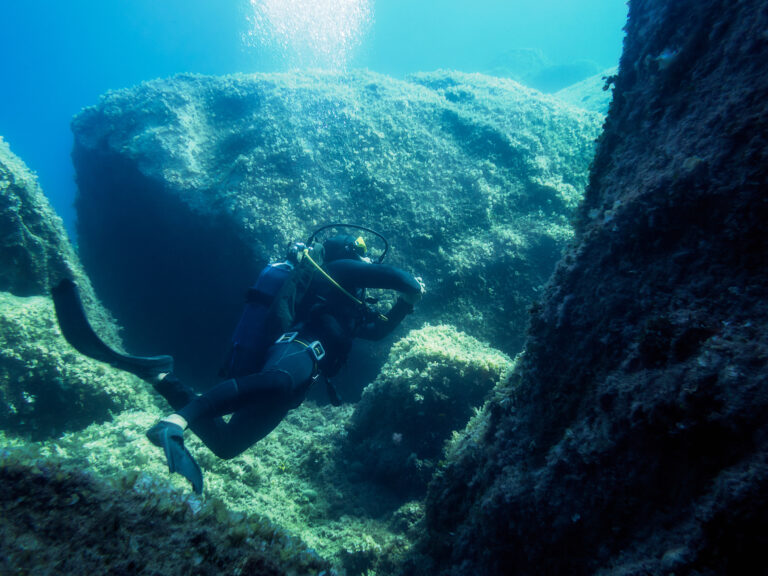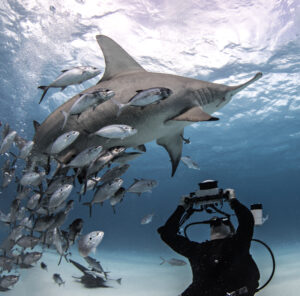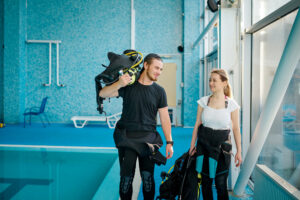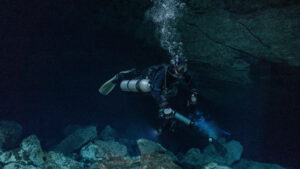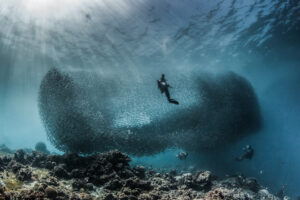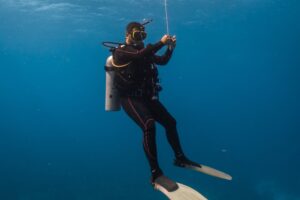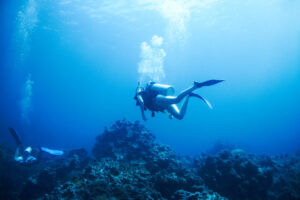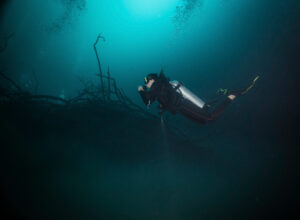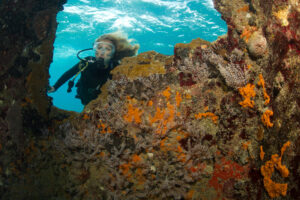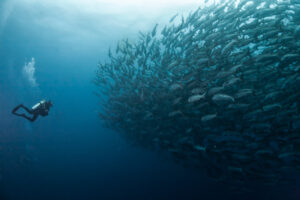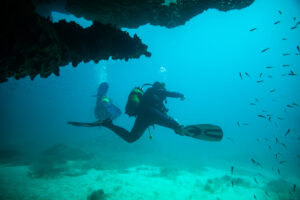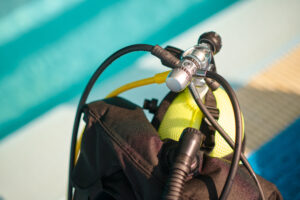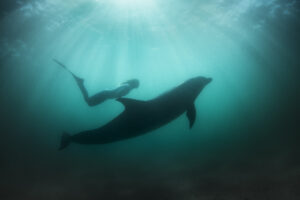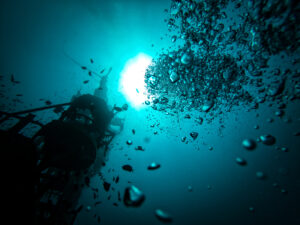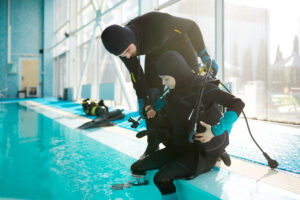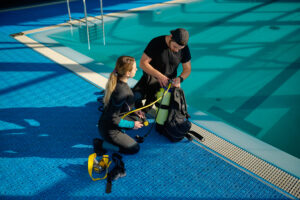What is Arterial Gas Embolism (AGE)?
Arterial Gas Embolism (AGE) is a potentially fatal complication that can occur during scuba diving, characterized by gas bubbles entering the arterial circulation. When these gas bubbles block blood vessels, particularly in the brain or heart, it can lead to immediate symptoms and rapid clinical deterioration.
The incidence of AGE is not very common but is potentially one of the most dangerous diving-related conditions. It is primarily associated with incorrect decompression procedures and breath-holding during ascent, but can also occur due to pulmonary barotrauma or equipment failure. It requires immediate medical attention and, if not handled correctly, can lead to severe injury or death.
Etiology of AGE in Scuba Diving
Improper Ascent and Decompression
Scuba divers are trained to ascend slowly and, if necessary, to make decompression stops to allow gas to be gradually and safely eliminated from the body. When a diver ascends too rapidly, particularly from a significant depth, the pressure reduction can cause gases dissolved in the body to come out of solution and form bubbles.
Improper decompression increases the risk of AGE significantly. The sudden pressure drop can cause bubbles to form and expand rapidly in the bloodstream. When these bubbles reach the arterial circulation, they can block blood flow and cause tissue damage.
Breath-Holding During Ascent
One of the cardinal rules in scuba diving is to never hold your breath. This rule is crucial to prevent AGE during ascent. When a diver ascends while holding their breath, the gas in the lungs expands due to decreasing pressure, which can lead to pulmonary barotrauma.
Pulmonary barotrauma, or lung over-expansion, can cause a rupture in the lung tissue, enabling gas bubbles to directly enter the arterial circulation. This condition is known as an arterial gas embolism. This complication can occur even during relatively shallow dives if the breath is held during ascent.
Clinical Presentation and Diagnosis
Signs and Symptoms
The signs and symptoms of AGE are varied and can occur immediately after surfacing or within several minutes. AGE primarily affects the central nervous system and cardiovascular system. Consequently, it can present with a wide range of neurological and cardiovascular symptoms.
Neurological symptoms can include confusion, unconsciousness, seizures, vertigo, and various sensory and motor disturbances. Cardiovascular symptoms may include chest pain, shortness of breath, irregular heartbeat, and, in severe cases, cardiac arrest. The onset is often sudden and dramatic, which is a key distinguishing feature of AGE.
Diagnostic Procedures
Given the potential for rapid clinical deterioration, immediate medical evaluation is essential if AGE is suspected. Diagnosis is primarily clinical, based on the history of diving and the presentation of symptoms.
Hyperbaric oxygen therapy is the standard treatment for AGE, even when the diagnosis is uncertain. Time is of the essence in these situations, and treatment should not be delayed for diagnostic testing. However, certain tests can be useful to support the diagnosis, to monitor the patient’s status, and to detect any complications. These tests may include chest X-rays, echocardiograms, or CT scans.
Prevention and Treatment
Diving Practices to Prevent AGE
Preventing AGE is primarily centered around following proper diving practices. These include controlled, slow ascent, avoiding breath-holding during ascent, and adhering to the correct decompression procedures. Training and experience play a crucial role in the prevention of AGE.
Another preventive measure is the use of appropriate diving equipment and its proper maintenance. Equipment failure, particularly of the breathing apparatus, can contribute to situations that might lead to AGE.
Treatment Modalities for AGE
In the event of suspected AGE, the first response is to lay the diver down, preferably on their left side and administer 100% oxygen. High-flow oxygen helps to displace the nitrogen within the bubbles, reducing their size and assisting in the resorption of gas into the bloodstream.
Immediate medical attention is required, and evacuation to a facility equipped with a hyperbaric chamber is a priority. The primary treatment for AGE is hyperbaric oxygen therapy (HBOT), which involves placing the patient in a chamber where they breathe 100% oxygen under pressure greater than sea level atmospheric pressure. This increased pressure helps shrink the size of the gas bubbles and improves oxygen delivery to compromised tissues.
HBOT should begin as soon as possible, preferably within a few hours of symptom onset. Delays in treatment can result in irreversible damage, highlighting the importance of early recognition and prompt action.
Long-Term Effects and Recovery
Prognosis of AGE
The prognosis of AGE depends on multiple factors, including the size and location of the embolism, the speed of treatment initiation, and the patient’s overall health status. With immediate treatment, full recovery is possible, particularly if the AGE was caused by a rapid ascent or breath-holding and treated promptly.
However, if treatment is delayed, or if the AGE is extensive, there may be lasting neurological or cardiac damage. This can lead to long-term effects such as cognitive impairment, motor dysfunction, or heart complications.
Rehabilitation and Returning to Diving
After AGE, a period of rehabilitation may be necessary, particularly if there are any residual neurological or cardiac effects. This could involve physical therapy, occupational therapy, or other supportive treatments.
The decision to return to diving after an episode of AGE should be made with great caution and only after thorough medical evaluation. In some cases, a diver may be advised to refrain from future diving activities to avoid the risk of recurrent AGE.
Understanding the Risks: The Role of Education
Importance of Diver Education
Education plays a significant role in the prevention of AGE. Divers need to be thoroughly trained in understanding the physics and physiology of diving, and in recognizing and managing potential diving emergencies, including AGE.
Good diving practices, including controlled ascent, proper decompression, and avoiding breath-holding, are emphasized in all diver training programs. Moreover, understanding the signs and symptoms of AGE can ensure prompt recognition and immediate action, which are key to improving the outcome.
Dive Planning and Risk Management
Part of diver education is learning how to plan dives carefully and manage risks effectively. This includes assessing personal health and fitness, checking and maintaining equipment, considering environmental conditions, and adhering to safe diving practices.
Regular refresher training and continuous learning are also essential. They help divers stay up-to-date with the latest knowledge and recommendations, and maintain their skills and confidence, further contributing to the prevention of diving accidents and complications.
In conclusion, Arterial Gas Embolism is a rare but serious complication of scuba diving that requires immediate medical attention. The key to preventing AGE lies in proper training, safe diving practices, and prompt recognition and treatment.
Decompression Sickness (DCS) vs Arterial Gas Embolism (AGE)
Distinguishing Between DCS and AGE
While AGE and Decompression Sickness (DCS) – also known as the bends – both involve gas bubble formation as a result of pressure changes, they present different challenges and require different approaches. It’s essential to distinguish between them, as their symptoms can overlap, and treatment, although similar, has important differences.
AGE is typically characterized by immediate onset of symptoms following a rapid ascent or breath-holding, often resulting in serious neurological or cardiovascular complications. In contrast, DCS usually presents more gradually, often within 1 to 48 hours after diving, and may include symptoms like joint pain, skin rash, fatigue, along with neurological symptoms.
Different Treatments
While both AGE and DCS necessitate hyperbaric oxygen therapy, the treatment protocols vary slightly. AGE typically requires a more immediate response due to the potential for rapid deterioration. The treatment pressure in the hyperbaric chamber is often higher for AGE than for DCS. The treatment tables for DCS, on the other hand, depend on the severity and type of symptoms.
Scuba Diving: A Sport of Responsibility
Diver Responsibility
While diving agencies, instructors, and dive centers have a role in providing training and ensuring safety, the diver also bears a significant responsibility. Adhering to the rules of safe diving, including not exceeding planned depths, maintaining a slow ascent rate, and never holding breath during ascent, is crucial to prevent AGE and other diving-related conditions.
Buddy Responsibility and Emergency Response
Scuba diving is typically a buddy sport, and your diving partner is an essential part of your safety net underwater. Recognizing signs of distress or health issues in a dive buddy can mean the difference between a close call and a severe outcome.
In the case of a suspected AGE, it’s essential to seek help immediately, administer emergency oxygen if available, and arrange for evacuation to a medical facility equipped with a hyperbaric chamber. Both divers and their buddies should be trained in emergency response procedures and be ready to implement them at a moment’s notice.
In essence, Arterial Gas Embolism (AGE) is a severe potential complication of scuba diving, largely preventable through proper training, equipment maintenance, and adherence to safe diving practices. It requires rapid recognition and immediate response for successful treatment. As with most aspects of scuba diving, prevention and education are crucial. By understanding and respecting the risks, divers can enjoy the underwater world safely and responsibly.
Implications for Dive Professionals
Role of Dive Instructors and Guides
Dive professionals, including instructors and dive guides, play a critical role in preventing incidents of AGE. Their responsibilities extend beyond teaching the basics of scuba diving to instilling a deep understanding of dive safety, including the risks and signs of AGE.
Professionals are also responsible for conducting pre-dive briefings, emphasizing safety procedures, including controlled ascent, decompression stops, and the importance of not holding one’s breath during ascent. They should also be vigilant during dives, watching for any signs of distress or improper technique that could lead to an AGE incident.
Scenarios and Drills
Another important role for dive professionals is running scenarios and drills that prepare divers for emergency situations. These can include simulated rapid ascents, dealing with out-of-air situations, or identifying and responding to signs of AGE in a buddy.
By providing hands-on experience in a controlled setting, scenarios and drills can help divers build confidence, sharpen their skills, and reinforce safety procedures, helping to prevent accidents and improve responses in the event of a real emergency.
Recreational vs. Professional Diving: Understanding the Risks
Risks in Recreational Diving
Recreational divers typically dive within limits that minimize the risk of AGE and other diving-related conditions. These limits include a maximum depth of 130 feet (40 meters) and no-decompression dives, meaning divers can ascend directly to the surface without mandatory decompression stops.
However, it’s important to remember that AGE can still occur within these limits, particularly if a diver ascends too rapidly or holds their breath during ascent. As such, recreational divers should always follow safe diving practices and be alert for signs of AGE.
Risks in Professional Diving
Professional divers, including commercial and technical divers, often work beyond the limits of recreational diving. This can include deeper dives, longer bottom times, and mandatory decompression stops. As a result, the risk of AGE is higher in professional diving.
Professional divers must undergo more intensive training, particularly regarding decompression procedures. They are also typically required to use more advanced equipment, such as dive computers that track depth and time and calculate decompression requirements.
However, regardless of the level of diving, understanding the risks of AGE and how to prevent it is crucial. In scuba diving, safety always comes first, whether you’re a first-time recreational diver or an experienced dive professional. As divers, we must always strive to understand the underwater environment and how it affects our bodies, and to respect the rules and procedures designed to keep us safe.
Recent Research and Innovations
Advancements in AGE Research
Our understanding of AGE is continually improving, thanks to ongoing research in diving medicine. Recent studies have provided more insight into the pathophysiology of AGE, including how gas bubbles form and behave in the body, and how they cause tissue damage. This research has potential implications for the prevention, diagnosis, and treatment of AGE.
Another important area of research is the development of decompression models and dive computer algorithms. These tools help divers plan their dives to minimize the risk of decompression sickness and AGE. They take into account various factors, including depth, time, gas mixture, previous dives, and surface intervals.
Innovations in Dive Safety and Training
Technological advancements have also contributed to diving safety. Modern dive computers, for instance, provide real-time information and alerts, helping divers maintain a safe ascent rate and adhere to decompression requirements.
Training methodologies have also evolved. Today’s dive training includes e-learning, virtual reality simulations, and other technology-assisted tools that enhance the learning experience. These advancements provide divers with a better understanding of diving physics and physiology, including the risks of AGE, and reinforce the importance of safe diving practices.
Key Takeaways
By understanding the intricacies of Arterial Gas Embolism (AGE), following safety guidelines, and continuously innovating and learning, we can enhance the safety of scuba diving. Indeed, scuba diving is not just about the thrill of exploring the underwater world, but also about ensuring that we do so with the utmost respect for our bodies’ limits and the environment we are privileged to explore.

